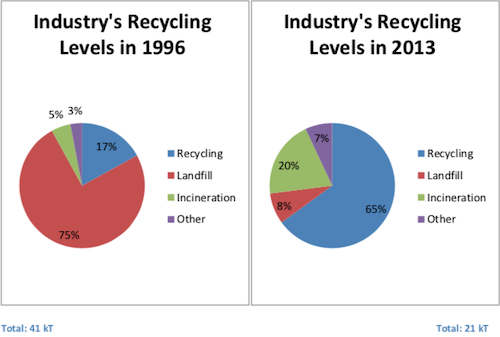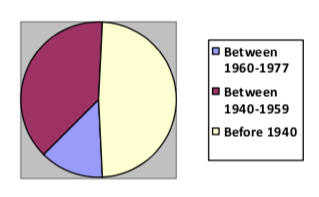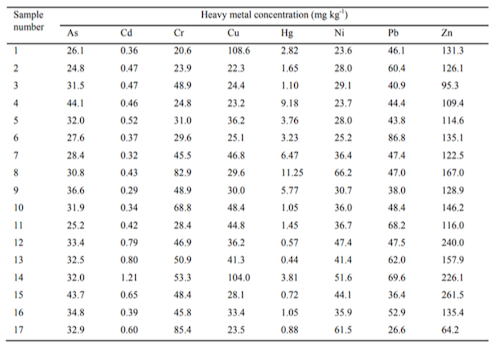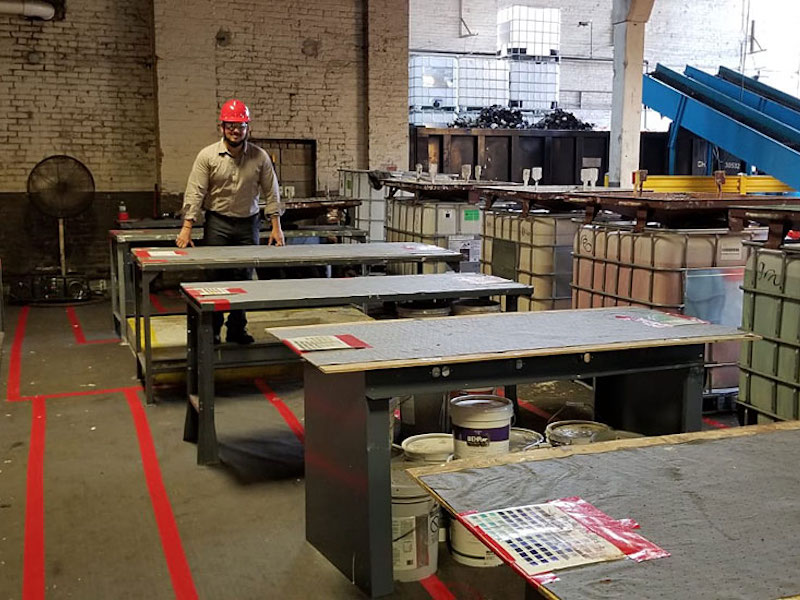Editor’s note: Huzaifa Matawala is the president of Matawala Group of Industries, a paint recycling consultant at Regent Paints, and the CEO of the Paint Foundation in New York, a 501c3 that has an innovative approach to recycling paint waste and reusing paints in an environmentally-conscious way.
There was a time when paint manufacturers couldn’t care less of the harm that they were causing to the Earth by dumping paint waste in landfills and burning fuels for their own good. Since then, the paint and coating industry has come a long way, and Paint Foundation has a big hand in it. It is good to see that the industry is starting to realize the importance of recycling leftover paint materials. Below is a pie chart that compares the industry’s recycling levels in 1996 and 2013.

The Paint Foundation’s program of reusing paints may not be the only program in the industry focused on recycling waste but it certainly is one-of-a-kind. I have conducted thorough research on the topic and boasts years of experience in the industry. I have successfully used millions of gallons of paint waste from across the world to create new industrial products using bio-friendly processes and programs. Thereby, our approach is beneficial and promising for industrial development as well as environmental welfare.
The Paint Foundation paint recycling program involves multiple steps. It converts solid latex into pulps, which are commonly used for new paints, bricks, and roofing products. They can also be used for flooring compounds.
Traditionally, paint manufacturers make paints, use them, and discard the excess product. It increases the carbon footprint and poses serious risks for the health and safety of the people. The Paint Foundation’s paint reusing program is different because it transforms the discarded paint materials into new bio-friendly products in a non-traditional facility.
To devise this efficient plan, we had to overcome many challenges and engage in several trials to make sure that the new products were usable and durable. It took a lot of effort and time to determine which materials and compounds were best suited for new industrial products and which process was ideal for converting leftover paints into profitable items.
Today, our approach provides an effective solution to factories and organizations to eliminate paint-related waste without harming the environment. We understand that not all paint facilities have the capability to put the entire paint items to good use and so, they end up dumping the leftovers in the environment. We collects and uses those materials to create new reusable products, including paints, coatings, plasters, and other industrial products. It goes as far as collecting cans from the unusable paints. I have thus combined my passion for manufacturing paints and his love for the environment in the best possible way.
Gaining Perspective
The paint industry has evolved in recent years, introducing edited formulations and enhanced products now and then. The global paints and coatings market value is expected to reach $232.1 billion by 2027.
This market growth is driven by several factors, including the growth of the automotive industry, improvement in economic conditions, and increase in urban population, construction expenditure, and household consumption expenditure.

However, one of the main challenges that the industry’s growth is likely to face is waste management. The process of industrial change means more raw materials and stock of items that need to be replaced with new ingredients. The more we start using new formulations, the more we are left with raw materials and items that we do not find useful in the industry. Hence, paint raw material manufacturers are left with tons of failure batches and obsolete materials.
Paint manufacturers had to think of a solution to get rid of all that waste. So, they started consigning the leftover materials to landfills. Another easy way out was to blend them into fuel. As it turns out, these solutions aren’t so viable after all. In fact, they are a major obstacle in our way when it comes to promoting a cleaner and greener environment.
The Problems with Land Burial and Fuel Blending
Climate change is one of the most discussed topics across the world and for good reasons. These changes are impacting the environment as well as human health in the worst possible way. One of the biggest reasons for these changes is the increasing carbon footprint of the paint industry.
Paint manufacturers who do not bother thinking beyond their goal of getting rid of unused paint do not have the slightest of an idea of the problems that come with land burial and fuel blending. Unused paint and paint-related waste materials have a significant environmental impact. Oil-based paints in particular tend to contain harmful substances and toxins that can damage the environment and have adverse effects on human life if buried in the land. They can contaminate drinking water, kill vegetation, and erode several industrial and commercial properties.
Fuel blending on the other hand may be an appropriate solution for flammable materials. However, we must realize that oil-based paints are usually packed with essential ingredients. Burning them into fuel means burning essential resins, pigments, metallic driers, wax, premium solvents, additives, and other valuable substances. Besides, every industry man knows that creating pigments requires a lot of resources and energy. The many resources, power, energy, and combinations of nature and technology that we invest in fuel blending can be used in a better way.
With the unique paint recycling program, the Paint Foundation wants to change the consumers’ perception that recycled paint is always lower quality. The innovative products produced from unused and leftover paint are as durable, credible, and saleable as any other product in the industry.
The Problem Goes Beyond Environmental Damage
Without realizing, we end up discarding and burning so much of the valuable ingredients that oil paints are made of. This, coupled with the cost, time and energy consumption of the raw material generation and paint production process, puts the paint and coating industry at a loss.
The Paint Foundation team evaluates the basic ingredients of the obsolete and leftover paint and group them into specific batches for the production of new products. The study of the raw materials in the paint plays a vital role in determining the final batches.
Insights into the Production of Paint Products
The complexity of a paint technology is determined by the number and types of raw materials required in the production process. A plant that manufactures a wide range of paints requires more than 500 raw materials, including resins, oils, pigments, minerals, solvents, metallic driers, and other materials.
Let’s go into the details of the raw materials used in the paint production process.
Alkyd Resins
Alkyd resins form the largest synthetic resins group in the paint industry. Considering their versatility and affordable cost, they are widely used for different purposes. The formation of alkyds involves the polycondensation of fatty acid and dibasic acid. Phthalic anhydride is the commonly used dibasic acid, while glycols, glycerols, trimethylolpropane, and pentaerythritol are utilized as fatty acids.
Emulsions
Emulsions are packed with tiny polymer particles which entraps the pigments. Nearly half of the emulsions are made of water. It also contains pigments (titanium dioxide for white, carbon for blacks, chromium oxide for greens, and iron oxide for yellows, reds, and browns). In addition to this, acrylic or epoxy polymers are used as binders and some additives, such as biocides are used to prevent fungi and algae’s growth on the surfaces.
Metallic Driers
 Generally, iron, lead, calcium, zinc, cobalt, manganese, zirconium, barium, vanadium, and lithium metals are used as driers for paint production. The organic part of dryers is made of medium-to-long-chain linear or branched acids, like abietic, linoleic, naphthenic, decanoic, octanoic, or neodecanoic.
Generally, iron, lead, calcium, zinc, cobalt, manganese, zirconium, barium, vanadium, and lithium metals are used as driers for paint production. The organic part of dryers is made of medium-to-long-chain linear or branched acids, like abietic, linoleic, naphthenic, decanoic, octanoic, or neodecanoic.
It is worth noting that lead-based paints have been banned since 1978 but many older homes still have older paint sticking under layers of newer paint. Deterioration in the form of peeling, chalking, and chipping can easily result in a biohazard for residents.
Minerals
The minerals commonly used for paint production include asbestos, chalk, graphite, jasper, limestone, manganese, pyrite, talc, silica sand, calcite, dolomite, gypsum, galena, red ochre, quartz, etc.
Solvents
Solvents are typically used to make the paint thin. Typical solvents include acetone, toluene, turpentine, methyl ethyl ketone, dimethylformamide, or any other glycol ethers.
Monomers
The main acrylate monomers used for paint production are methyl methacrylate, butyl methacrylate, butyl acrylate, glacial methacrylic acid, vinyl acetate monomer, glacial acrylic acid, and 2-Ethylhexyl acrylate.
Paint Recycling to the Rescue
The Paint Foundation believes in using the practice of reusing paints as the first line of action for reducing carbon footprint and promoting a greener environment. I am an advanced paint recycler who is making reuse of paints a global phenomenon. The paint recycling program that we have launched through his companies is aimed at reducing paint-related waste and creating new products using materials that would not have been utilized otherwise.
Following a process similar to latex recycling, the paint recyclist and the team investigate the ingredients of leftover paint and assess the resin chains that have formed as a result of chemical reactions. The components are then grouped in different batches to be used for the recreation of industrial products.
I am now waiting for the U.S. Patents and Trademark Office to approve patents for recycling processes and 13 innovative oil paint formulations. One can gauge the significance of our approach to reducing paint waste only if they understand the advantages of reusing paints.
5 Advantages of Reusing Paints
The following are the top five advantages of reusing paints.
1. Protects the Environment
Dumping paint-related waste in landfills allows toxic substances to enter the environment and cause harm to it. When oil-based paints, such as alkyd and latex dry up in a landfill, they release volatile organic compounds and pollute the air. These vapors promote the formation of ozone and give way to smog, which is neither good for the environment nor the humankind.
Americans alone discard more than 65 million gallons of paint every year. Paint waste takes 700 years to decompose after it is dumped in landfills. A 5-liter gallon of paint may result in 13.58 kg CO2e. CO2e measures the impact of various GHG emissions in terms of CO2 emissions that would result in an equivalent level of global warming impact. And when it comes to carbon footprint, leftover paint that goes to waste has the most significant impact on the environment.
Traditional pigments in paint are rich in toxic heavy metals that can contaminate the soil by leaching into it. To demonstrate this, researchers at Zheijang University carried out an analysis of the soil in the site of a retired paint manufacturer in Hangzhou, Zhejiang. They discovered that the soil contained a toxic combination of As, Cu, Hg, Ni, Cd, Zn, and Pb as well as chromium.
The high levels of Hg, Cd, and As pollution in the soils were particularly alarming. Long-term exposure to these metals can damage blood composition, kidneys, lungs, liver, and affect other vital organs. Studies also show that exposure to heavy metals can cause degenerative neurological processes that operate just like Parkinson’s and Alzheimer’s disease.
Below are the concentrations of various metals (in milligrams per kilogram of the soil) of the retired paint manufacturer.

A comparison of these values to the maximum allowable limits (MAL) for heavy metals in the soil also showed alarming results. In fact, Mercury concentrations in 12 subsoil samples, 9 basal soil samples, and 9 topsoil samples were higher than its MAL. Similarly, Arsenic concentrations in 2 subsoil samples, 2 topsoil samples, and 3 basal soil samples were higher than its MAL. Cadmium levels exceeded its MAL in 1 topsoil sample, 1 subsoil sample, and 1 basal soil sample.
The soils that contain high values of heavy metals are to be treated as hazardous substances.
Recycling and reusing paints help protect the environment and ensures safe disposal of the volatile organic compounds and other flammable substances. This way, harmful substances will not be able to enter the local ecosystems and our planet will remain free of toxins.
2. Saves Resources
Reusing paints is a great way to conserve resources. You may be surprised to hear that reusing a gallon of paint that would otherwise go to waste allows you to save 100-kilowatt hours of energy spent on making new paint. Yes, that’s a lot.
Furthermore, a study showed that the characterization of zirconium, silicon, aluminum-coated titanium dioxide pigments were recovered from paint waste. If we go into the details, titanium dioxide is a commonly used white pigment in the paint industry. It contributes to nearly 75% of the carbon footprint of a tin of paint. The production of this pigment is believed to yield a high carbon footprint. Recycling of paint waste may serve as an alternate, environmental-friendly source of this pigment.
Let’s also tell you that some latex paints when recycled produce biomass fuels that you can’t otherwise produce without investing additional energy and using new organic materials. You may also reprocess other latex paints into new paints and coatings or even use them to make innovative concrete products.
3. Saves Time and Energy
Reusing paints also helps you save a lot of time and energy that you would otherwise spend on extracting natural resources and importing raw materials for industrial paints. To create new products, we have to extract gums from trees, obtain oils from the sea, and erode mountains for minerals. The process of reusing paints saves us time, cost, and energy as well as prevents many natural resources from going to waste.
4. Reduces the Size of Landfills
The maxim ‘out of sight, out of mind’ can easily be used for the unusable paint materials that you toss in the trash can regularly. However, it is crucial to look at the bigger picture and realize that all that trash only increases the size of the ever-growing landfills.
You must at least try to understand how your actions impact the planet we live in. When you bury the paint-related waste in the land or blend it into fuel, you end up promoting the greenhouse gas emissions, such as methane and carbon dioxide. Just imagine the level of damage these harmful gases can cause to our environment over time!
The practice of reusing paints is an excellent way of managing waste and protecting our environment from toxic substances while opening new doors of opportunities and innovation in the paint and coating industry. Recycling one gallon of paint can help you save 13 gallons of water, 13.74 pounds of carbon dioxide, 250,000 gallons of water pollution, 1 quart of oil, and enough energy to power an average home for 3 hours.
5. Development of New, Innovative Products
Reusing discarded paints allows you to create innovative, environmental-friendly products that can be used in the industry. These products can be used for a variety of purposes. The procedure may seem lengthy but it indeed is bio-friendly and cost-effective. So, instead of dumping leftover paint materials, you can simply use them to create new saleable products that do not cause harm to the environment and can be used in the industry in the long run.
The Bottom Line
We’re incredibly proud of the innovative work the Paint Foundation has been doing in the paint and coating industry. Land burying and fuel blending of unused, discarded, and leftover paint do more harm than good. Recycling and reusing these materials is an excellent way to save our environment and preserve the health and safety of the people.
Moreover, reusing paint allows us to save the resources that are generally used for making new paint and the energy utilized to make and transport the paint, pigments, minerals, and chemicals. Simply put, recycled and reused paint reduces landfill waste, pollution, and overall carbon footprint while saving resources, energy, cost, and time.
Huzaifa Matawala is CEO of the Paint Foundation. Please visit https://thepaintfoundation.com/



































